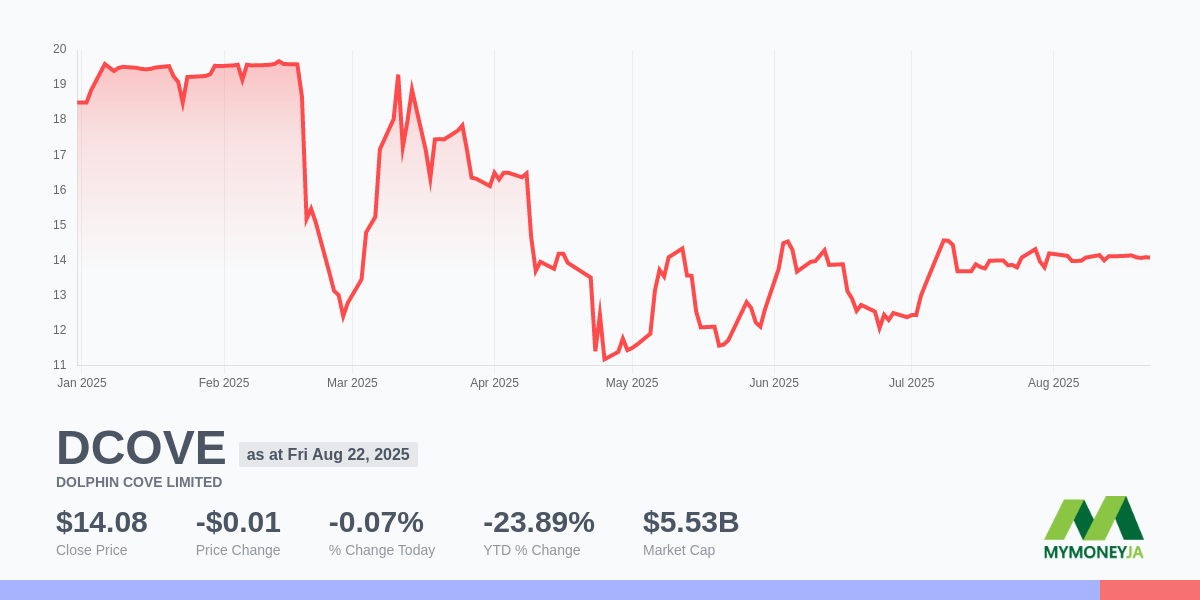DCOVE Analysis: Financial Distress Meets Regulatory Crisis
How Mexico's dolphin entertainment ban compounds existing corporate distress at Dolphin Cove's parent company, creating potential market inefficiencies for informed observers
The Convergence of Corporate Distress and Regulatory Change
The intersection of existing corporate financial distress and new regulatory developments has created an unusual situation around Dolphin Cove Limited (DCOVE) on the Jamaica Stock Exchange. This analysis examines how these converging factors may create market inefficiencies for informed observers to understand.
Key Analytical Points
- Parent company bankruptcy preceded Mexico's dolphin ban by several months
- Regulatory changes compound existing financial pressures on distressed corporate structure
- Cross-border ownership complicates asset recovery and cash flow patterns
- Market may be pricing multiple overlapping risks inefficiently

Understanding the Corporate Structure
DCOVE's Position in a Distressed Corporate Chain
Dolphin Cove Limited operates as a subsidiary within a complex ownership structure that includes The Dolphin Company (Mexico), which filed for Chapter 11 bankruptcy protection in March 2025 - months before Mexico's regulatory changes.

📈 DCOVE Stock Overview
Current trading data, financial metrics, and stock performance for Dolphin Cove Limited
👥 Top Shareholders Analysis
Ownership structure showing 79.99% control by parent company entities

Corrected Timeline: Bankruptcy First, Ban Second
Understanding the Sequence of Events
It's crucial to understand that the corporate financial distress preceded the regulatory changes, not the reverse. This timeline helps explain the current situation more accurately.
The Dolphin Company begins defaulting on debt obligations
Delaware bankruptcy case 25-10606, $200M+ debt, DCOVE shares pledged as collateral
Former CEO Eduardo Albor allegedly seizes facilities with armed personnel
Dolphin entertainment ban signed into law, adding regulatory pressure to existing distress
Eduardo Albor and three Mexican directors removed from DCOVE board
Financial Performance Under Pressure
DCOVE's Operational and Financial Metrics
The subsidiary's financial performance shows deterioration that began before the regulatory announcement, suggesting operational challenges independent of the Mexican ban.
| Metric | 2024 | 2023 | Change |
|---|---|---|---|
| Revenue (USD) | $7.51M | $8.40M | -10.6% |
| Net Profit (USD) | $1.83M | $3.07M | -40.3% |
| Working Capital (USD) | $2.5M | $4.4M | -43% |
| Dividend Yield | 5.62% | 9.42% | -40.3% |
| Dividend Payments/Year | 2 | 3 | -33% |
Mexico's "Ley Mincho" - Regulatory Compound Effect
How the Dolphin Ban Adds Pressure to Existing Distress
While not the cause of the financial distress, Mexico's comprehensive dolphin entertainment ban creates additional operational and financial pressures on an already struggling parent company structure.

Dividend Yield in Context
JSE Comparative Analysis
DCOVE's dividend yield positioning relative to other Jamaica Stock Exchange companies provides context for understanding market perceptions and potential value propositions.
Dividend Payment Patterns Reveal Corporate Stress Timeline
DCOVE Dividend History: A Story of Declining Distributions
The dividend payment history from 2020-2025 reveals a clear pattern that aligns with the parent company's financial deterioration, providing concrete evidence of the stress timeline.
| Year | Total Dividends (JMD) | Payment Count | Yield | Yield Change |
|---|---|---|---|---|
| 2025 | $0.60 | 1 | 4.19% | -25.4% |
| 2024 | $1.20 | 2 | 5.62% | -40.3% |
| 2023 | $1.60 | 3 | 9.42% | +112.3% |
| 2022 | $0.80 | 2 | 4.44% | +45.8% |
| 2021 | $0.40 | 1 | 3.04% | -21.7% |
| 2020 | $0.30 | 1 | 3.89% | - |
Critical Dividend Pattern Insights
- 2023 represents the peak with 9.42% yield and three payments - possibly maximum extraction before distress
- 2024 saw a 40% yield decline and reduction to two payments as financial pressure mounted
- 2025 shows only one payment so far (June) at 4.19% yield - significant deterioration
- Payment frequency declined from 3 times (2023) to 2 times (2024) to 1 time (2025 YTD)
- The 2023 spike aligns with the period before parent company default escalation

Potential Scenarios for Market Observers
🟢 Resolution Scenario
Factors: Successful debt restructuring, operational efficiency improvements, tourism recovery
Considerations: Cross-border complexity, regulatory compliance costs
🟡 Continued Pressure
Factors: Partial debt resolution, reduced operations, tourism sector volatility
Considerations: Extended bankruptcy proceedings, currency fluctuations
🔴 Asset Liquidation
Factors: Failed restructuring, asset sales, operational shutdowns
Considerations: Recovery values, liquidation timelines, priority structures
Risk Factor Analysis
Multiple Overlapping Risk Categories
Understanding the various risk factors helps explain the current market positioning and potential future scenarios.
Delaware Chapter 11 case with pledged collateral and creditor claims
79.99% control by distressed parent company entities
JMD volatility affects USD-based parent company value extraction
Revenue and profit deterioration predating regulatory changes
Parent company facility closures affect overall corporate viability
Concentrated ownership limits trading flexibility

Jamaica Tourism Sector Context
Underlying Sector Strength Despite Corporate Challenges
Jamaica's tourism sector demonstrates resilience that provides operational context for DCOVE's business environment, separate from parent company financial distress.

Analytical Framework for Market Observers
Understanding Distressed Corporate Dynamics
This situation provides educational value for understanding how multiple pressures - pre-existing financial distress, regulatory changes, and cross-border complexity - interact in public market contexts.
- Timeline sequence matters in understanding causation vs correlation
- Corporate structure complexity affects resolution pathways
- Market pricing may reflect multiple overlapping concerns
- Regulatory changes can compound existing operational challenges
- Cross-border ownership creates additional analytical complexity
Monitoring Framework for Continued Analysis
Delaware Case 25-10606 developments and creditor actions
Quarterly distribution decisions and policy changes
Tourism recovery, operational efficiency improvements
Mexican facility closure timelines and compliance costs
Educational Summary
Multiple Pressures Create Complex Market Dynamics
The DCOVE situation demonstrates how pre-existing corporate financial distress can be compounded by regulatory changes, creating complex market dynamics that require careful analysis to understand properly.
Key Analytical Takeaways
- Bankruptcy proceedings preceded regulatory changes by several months
- Multiple overlapping pressures may create market pricing inefficiencies
- Cross-border corporate structures add complexity to resolution processes
- Understanding timeline sequence helps separate causation from correlation
- Operational metrics may diverge from parent company financial distress

